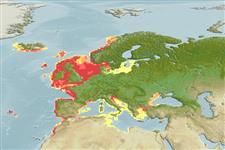Common names from other countries
Environment: milieu / climate zone / depth range / distribution range
Ekologi
; kisaran kedalaman 0 - 150 m (Ref. 4), usually ? - 50 m (Ref. 4). Subtropical, preferred 12°C (Ref. 107945); 69°N - 29°N, 28°W - 32°E (Ref. 4)
Eastern Atlantic, Mediterranean and Black Sea. Not in east of Crete and in the Baltic Sea.
Length at first maturity / Size / Weight / umur
Maturity: Lm 8.9, range 8 - 8.3 cm Max length : 65.0 cm TL jantan/; (Ref. 441); common length : 40.0 cm TL jantan/; (Ref. 441); Berat maksimum terpublikasi: 6.0 kg (Ref. 4); Umur maksimum dilaporkan: 72 Tahun (Ref. 81081)
Common total length: 23 to 50 cm. Occurs on the continental shelf at depths of 0 to 150 m, usually not deeper than 50 m. Found on hard substrates such as rock or hard mud. Nocturnal and territorial living in holes or crevices. Females with eggs are usually found throughout the year. The eggs are laid around July and carried for 10 to 11 months (Ref. 4). Indiscriminate scavengers, omnivorous or carnivorous. Feeds primarily on malacostracan crustaceans, gastropod mollusks, and polychaete annelids; but diet known to include carrion, echinoderms, lamellibranchs and plant matter (Ref. 96319).
Females with eggs are usually found throughout the year. The eggs are laid around July and carried for 10 to 11 months (Ref. 4). Coupling occurs a few days after the female molts (Ref. 80921).
rujukan utama
Acuan | Koordinator | mitra
Holthuis, L.B. 1991. (Ref. 4)
Status IUCN Red List (Ref. 130435)
status CITES (Ref. 108899)
Not Evaluated
Not Evaluated
penggunaan manusia
Perikanan: bernilai komersial tinggi; Budidaya air: percobaan
FAO - Perikanan: landings, profail spesis | FishSource | Sea Around Us
Alat, peralatan
Sumber internet
Estimates based on models
Preferred temperature
(Ref.
115969): 7.7 - 13.3, mean 10.4 (based on 494 cells).
Daya lenting
Tinggi, Waktu penggandaan populasi minimum kurang dari 15 bulan (K=0.79-1.0; Fec=13,000).
Prior r = 0.37, 95% CL = 0.25 - 0.56, Based on 1 data-limited stock assessment.
keancaman
Moderate to high vulnerability (46 of 100).
